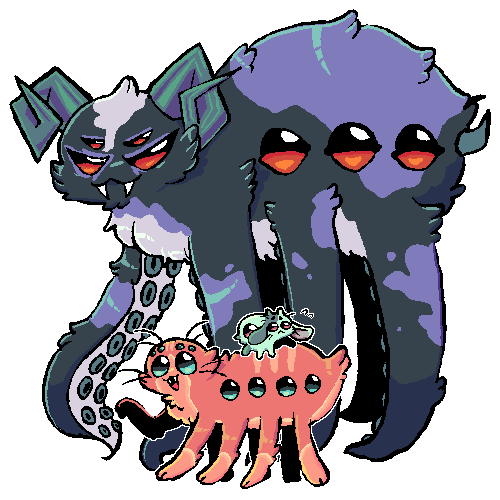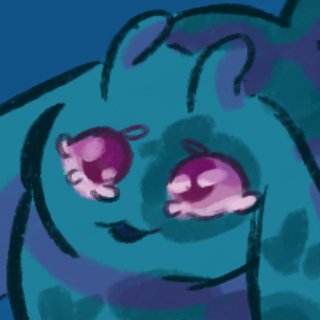[Cosmosdex] The Universal Encyclopedia
[Cosmosdex]
Squibbin
Octo-Spider-Cat / Doll's best friend
Squibbin

Art by, dr9com9ge
- Strength-3
- Intelligence-1
- Charisma-1
- Endurance-2
- Agility-8
- Luck-0
Danger Level: Low
Likes: High places to hang off of, Bobbing along in water, Napping, Webbing things up, Fish, Observing things
Dislikes: Loud noises, Things they cannot web on, Lemon juice or anything that irritates eyes, Being quite low on the ground, Predators
Attack Method: Squibbins will usually resort to biting at vital parts of their targets, They will also whip around their tentacles and wrap them around limbs in an attempt to immobilize them.
Attributes
Environment: Trees, Valleys, Cities, SwampsLifespan: 88 years
Size: 1 ft tall, 2 ft long
Diet: Meat, Fish, Insects
Bodytype: Multiped
Type: Molluscoid Mammal
Rarity: Common
Original Creator: dr9com9ge
Physical Description
Squibbins are fluffy multi-limbed creatures that resemble plush spiders native to Nukotii. Instead of having segmented bodies similar to arachnids, they are soft bodied and have no bones aside from their jawbones. Their eight "legs" are actually tentacles they use to climb up surfaces and slide down their zipline-like, blotchily colored webs that connect between trees or even valleys. Though they are usually found in high places such as those. squibbins are also semi-aquatic and can be found in swamps and ponds as well. Usually those found around the bogs are mother squibbins with their egg sacs floating in the pond as well as their kittens. Squibbins have a special organ they can inflate and deflate to allow them to float on the surface of ponds.
Squibbins being in the middle of the food chain have developed many eyes. six on the face. The bottom pair of which are much bigger than the other higher eyes. They also have twelve lateral eyes that run down the sides of their bodies. They will usually have their lateral eyes open when they sleep to spot danger or potential prey. Wild squibbins have venom that liquefies flesh. This is used to incapacitate smaller prey and deter predators. A wild squibbin bite could easily melt a finger off and it is advised to get treatment immediately. Fortunately the venom in domestic squibbins have been bred out while appearances have been diversified, thus pet squibbin bites only cause some minor damage to the area bitten and possibly your feelings. Though the same can't be said for some subspecies as those get far larger than their common cousins.
Domestic squibbins have been bred for more than just losing their venom. Breeders have made squibbins that have all sorts of different bright colors and patterns which contrasts wild type squibbins who are usually the same color as their environments and typically much more dull. These domestic squibbins also tend to shed fur a bit more due to having more soft fluffy fur. Though unfortunately some breeders have bred squbbins with limbs that are far too curly or too short and eyes that are far too large which causes them to have trouble moving and seeing. Though most domestic squibbins are free of these problems.
Behavior
Squibbins are quite curious yet cautious critters. They will follow unfamiliar creatures at a distance with their groups. If said creature does not pose any threat to them squibbins will come closer to investigate and sniff said unknown animal. Usually after sniffing the squibbins will lose interest and leave whatever it was alone unless it is small enough for the squibbin to eat. In which case the squibbins can and will catch said small animal and web them up.
Squibbins are known to toy with their prey and show off their catch to other squibbins as well their owner. After it gets bored it will finally eat the prey. Though mainly their prey is caught using the webbing spread across two ends of a valley, This prey is usually small to medium sized flying beasts. But this does not stop multiple squibbins teaming up to hunt and catch bigger prey like screegles ,which are giant four winged birds with serrated beaks, the apex predators of their homeplanet. Though, these hunts usually end with the screegle breaking out of the webs. This does deter the screegle from coming back, but does not deter the squibbins from trying to bite more than they can chew when it comes to hunting.
Squibbins will play-fight with each other, This often leads to two squibbins rolling around as their group surrounds them and watch. This watching behavior is also seen when the group or even a singular squibbin finds something they think is interesting. It is also a common sight to see squibbins tangling their limbs with others in their group. These "tangles" as they're colloquially called are how squibbins show affection. They will tangle with literally anything they are quite fond of: This tangling behavior seems to be consistent across subspecies. Even the large and typically aggressive krackats have been recorded to have tangled with their handlers in captivity. Squibbins also seem to like when they are held upside-down by their legs and swung a bit by their owners. It seems to be similar enough to sliding down their webs which they enjoy doing very much.
Squibbins being semi aquatic also enjoy swimming and floating around and it's advised to have a small pool of water for one to swim in.
Squibbins when they aren't actively hunting or playing, are quite lazy and laid back. Often taking naps near their webbing. However, they will keep lateral eyes open while they sleep, unless they feel completely safe. A domestic squibbin may web up their favorite spot in the house and more much to many owner's dismay or delight- Depends if they like having the splotchy ink stained webs hanging around like streamers. Though squibbins can be trained to not web everywhere with some effort.
Subspecies
Krackat: The larger and more aggressive mountain-dwelling squibbins. A Krackat sports a pair of ram-like horns and an actual skull to support said horns as well as a larger jaw full of razor sharp teeth with large fangs. They also have much thicker coats to handle to lower temperatures of the few mountains of nukotii. Though ones on lower places may need to be shaved a bit to avoid overheating. Krackats have less limbs and eyes. Four facial eyes, six lateral eyes and six thick powerful tentacles. These tentacles have suction cups with sharp hooks used to latch onto the sides of mountains and to fight off those who encroach on their territory. Unlike their common cousins, krackats are strictly solitary animals who will fight any other krackat that comes near its space. The exceptions to this are when it's mating season, or the krackat has krackittens. Krackats are also known for holding long lasting grudges and remembering its foes. These grudges even pass down to their babies, But they also will remember bonds with others as a krackat will help those who have been kind to it in the past.
Fluttermew: The hand sized gliding cousins of the common squibbin. These tiny squibbins have developed webbing across six tentacles and large ears to assist in gliding. They are small and lightweight enough for the breeze to pick them up and allow them to glide. They have four facial eyes and two large lateral eyes. Their small size has made them very fearful of other creatures which are much larger than them. as they are often seen shivering and shaking in the presence of bigger critters. They will also make loud high pitched mews if they are caught to warn the rest of its group to flee. Their large ears can pick up a wide range of sounds and are quite sensitive. A fluttermew can hear the sounds of some other creature breathing a few feet away and will usually try to hide in that time. But being quite cute these little squibbins are popular pets and are often taken from the wild. Though it is necessary to have more than one as they get lonely and will continue to be terrified. Fluttermews are also quite commonly preyed on and will have as many babies as possible in hopes a few survive.
Truthseeker: Possibly the rarest and most elusive subspecies of squibbin. Not much is known about this subspecies' behavior due to the dangers of encountering one to one's sanity. The one specimen used to study this subspecies was found dead near a seaside town. It had about eighteen eyes asymmetrically placed on its body, notably having a "third" eye on the forehead and a large eye on the back. It seemed to lack a mouth at first, but it turned out it was on the back end instead of the face. The large mouth containing all flat teeth instead of the typical sharp teeth and fangs of a most squibbins. The few illusorii who had seen living ones have suffered ill effects to their minds. One individual had stated they saw visions of bizarre yet familiar feeling places. This individual and many others have felt like they needed to find the particular truthseeker they had seen. So much so that it became an obsession that took over their lives. Most of these illusorii have gone missing or had been found turned into ugly truths. One former researcher of this subspecies and particular topic had said "It's like they've seen something and it was too much for them- I'm afraid it will be too much for us as well..." before quitting their job and leaving.
Special
Inky webbing: Squibbins can both spray ink and spin webs. Though the silk will be stained in an odd splotchy patterns making it white in some parts and a dark almost blackish-blue in other parts. This patterning is used to confuse flying prey who crash into the long webs the squibbins make. The silk from these webs can also be spun into soft textiles.
Trivia
• Squibbins are by far the most common pet owned by illusorii and on their home planet, Nukotii.
• Squibbin eggs are a delicacy in some places in the universe as boiling them yields something similar to a ravioli with creamy soft boiled egg filling. Though it is frowned upon to eat the eggs near an illusorii as all of the eggs that are laid are going to hatch into new squibbins and they absolutely love squibbins.
• Krackats are sometimes raised from krackittens to be on farms where their fur is shaved off and used to make sweaters and fur coats or to be service animals. These krackats are far more docile than their wild territorial brethren.


